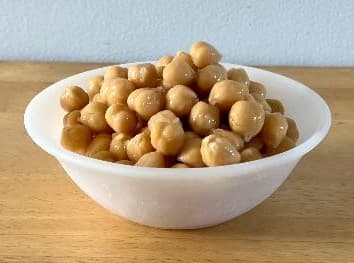How to Grow Chickpeas (Garbanzo Beans)

Learn How to Grow Chickpeas
Growing Chickpeas for the first time? This “How to Grow Chickpeas” guide helps both new and experienced gardeners to grow a great crop of chickpeas.
Chickpeas are also called “garbanzo beans”. They are tasty little legumes. They are great in salads, soups, and stews. But, you probably know them best as the main ingredient in hummus and falafel. They are native to the Middle East. The countries of Egypt, Israel, and Lebanon each claim to be where Chickpeas originated and were first used by humans. They are eaten by both humans and animals. The plants produce 1-inch pods with one of two peas per pod.
In addition to culinary uses, Garbanzo beans are used medicinally. They have been used medicinally to lower cholesterol levels, reduce the risk of cancer, and to ease hunger pangs.
Chickpeas are fairly easy to grow but require a long growing season, about 100 days. As a result, many people start them indoors. They are not great container plants, as the yield per plant is low. If you do grow them in containers, we recommend using at least a 12″ diameter pot.
Botanical Name: Cicer Arietinum
A Pea or a Bean?
People who call them Chickpeas, are most likely to consider them peas. On the other hand, as their name implies, Garbanzo Beans are considered beans by some folk.
As noted above, they are a legume. And from a botanical perspective, they are peas.
Call them what yu will. Frankly, we don’t care whether you call them peas or beans, as long as you have fun growing and eating them!
How to Grow Chickpeas - Sowing Seeds
Because of its long growing season, many people start chickpeas indoors. However, chickpeas do not transplant well. So, if you are starting them indoors, use peat pots or pellets. Start them four weeks before the last frost in your area. Sow two seeds in each peat pot. Thin seedlings to one plant per pot, before transplanting into your garden. Use scissors to cut culled plants at the soil level, to avoid disturbing the roots of the remaining plant. On transplanting day, plant the seedling, pot, and all. Plant them deep enough to completely cover the peat pot.
Direct sow seeds outdoors one to two weeks before the last frost. Mix in a generous amount of compost and/or well-aged manure before planting. Do not use green “hot” manure, which has high levels of nitrogen.
Final plant spacing is 5-6 inches apart in rows 18-24 inches apart. The plants tolerate a little crowding and benefit by helping to support each other.
Young plants are somewhat frost tolerant.
Seeds germinate in 10-14 days.
How to Grow Chickpeas or Garbanzo Beans
Growing garbanzo beans is fairly easy. They grow best in warm, not hot weather, ideally 70-80 degrees F, with nights that remain in the sixties. Chickpeas do not like heat. In hot weather the plant stunts or slows, its growth. Young plants are a little frost tolerant. Early fall frosts can cause flowers to drop.
Grow plants in full sun.
Chickpeas grow best in loose, loamy soil that is well-draining. It does not need to be too rich.
Fertilize plants no more than every three to four weeks. Chickpeas have “nitrogen-fixing” roots. Which means they put nitrogen into the soil. Too much nitrogen will result in big, bushy plants, with fewer flowers and pods. Either avoid nitrogen fertilizers or use a low nitrogen formula. Mineral-rich liquid fertilizers, like liquid fish or seaweed, have no nitrogen and are great for your chickpea plants.
Avoid overwatering plants. Water them as needed in dry weather. Keep the soil moist, not wet. The roots are shallow, so you do not need to water deeply. Water at the soil level, avoiding overhead sprinklers. Water on the leaves can invite plant disease.
Weed carefully around plants, to avoid disturbing shallow roots. We suggest you use garden snippers to cut weed stems off at ground level.
Mulch around the plants to keep weeds down and to help retain soil moisture in the hot, dry summer months.
Also, See:
Ideal Soil pH: 5.3 – 7.0
Insects and Pests
A variety of insects may infest the plants. Use insecticides or insecticidal soaps only as needed.
Plant diseases include mold, blight, mildew, mosaic, and anthracnose. To minimize plant disease, avoid getting the leaves wet, and improve air circulation by avoiding bushy plants. Discard and remove diseased leaves and plants. Use fungicides only if needed.
Mice and rodents like chickpeas.
Plant Disease
Like garden peas, their cousins, summer heat and humidity, bring plant diseases that can befall these plants.
Fungicides can be used in areas of high heat and humidity. However, we recommend you find out whether it is a problem in your area first.
How to Grow Chickpeas- Harvest Time
To eat fresh Chickpeas, pick pods when they are still green.
For dried Chickpeas, harvest when the plant leaves are dry and have turned brown. Or, pull plants and put them on a flat, warm surface to let the pods dry. Provide good air circulation. Collect the seeds as the pods open.
Fresh garbanzo beans can be stored in the refrigerator for about one week. For dried chickpeas, put them in an airtight container and store them in a cool, dry place. Dried chickpeas can be stored for up to a year.
Chickpeas can also be frozen or canned.
Related Articles
Please support our site. Shop for:
- rmmatthews100@hotmail.com
- 585-721-6528
- Rochester, NY
©1999-2024 GardenersNet.Com, All Rights Reserved

